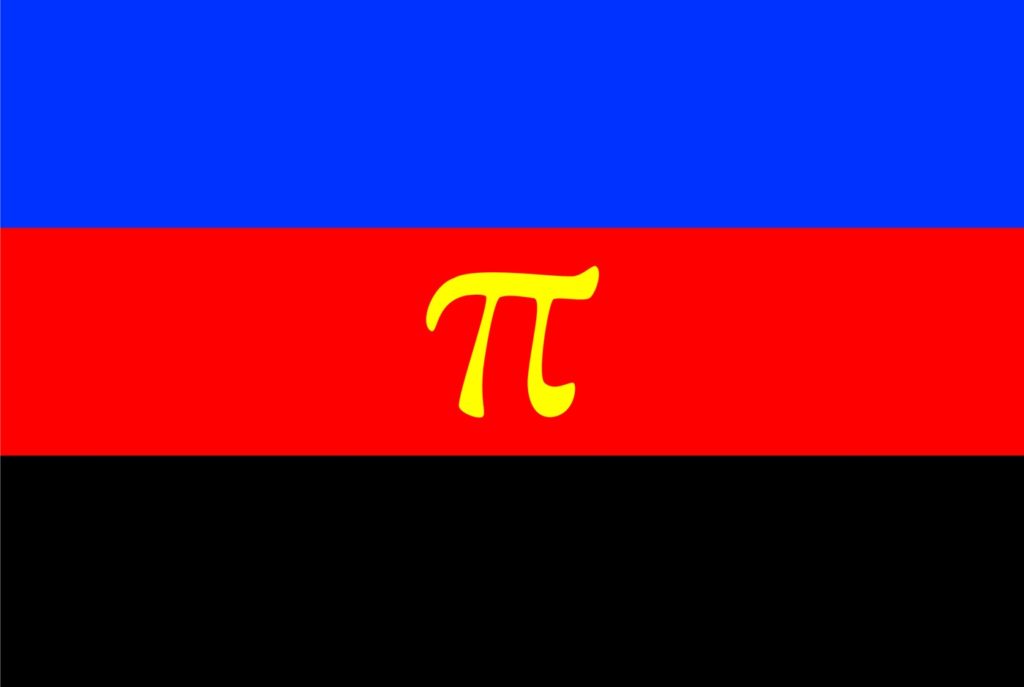Since flags are practical and popular symbols for many movements, you may be wondering if there is a polyamorous flag.
Yes, there is a poly flag!
However, the story of the polyamorous flag is mixed up because most polyamorous people don’t care for the poly flag and don’t use it. There have been new attempts to design and wave a number of different flags, or use other symbols, in hopes of cementing them in the greater imagination.
None of the poly flags resonate with everyone, for different reasons that we will look at.
What Does the Poly Flag Look Like?
The polyamory flag has three equal bars of color, each one taking up a horizontal third of the flag—blue on top, red in the middle, and black at the bottom. In the center of the poly flag is the pi symbol in yellow.
This flag was created in 1995 by Jim Evans and has been used ever since, with pride by many and reluctantly by others.
What Is the Meaning of the Polyamory Flag?
The colors of the poly flag were chosen with Microsoft Paint. Blue symbolizes honesty and trust among partners; red symbolizes love and affection; and black symbolizes space for those who have had to live invisibly or face discrimination for their choices against the mainstream.
More puzzling is the pi symbol. Some say it is simply because it starts with a “P.” Others say pi is the number of eternity and infinity. Still others say that the pi symbol on the polyamory flag was chosen because there were limited symbol options at the time in the software program Evans was using.
Detractors say that the flag design is harsh and looks more like it should signify an engineering or math committee rather than a flag for the polyamory lifestyle.
It is assumed that the pi symbol was chosen to signal polyamory to others discreetly, because it was created when polyamory was hush hush and was meant to wave to others in the know, rather than proclaim pride or announce polyamory to outsiders.
Is There a New Polyamorous Flag?
Because so many poly people are unhappy with the polyamory flag, there have been a number of poly flags designed in hopes of replacing it.
One polyamory flag you will see softens the strong, vintage colors into pale blue, hot pink and black and replaces the “pi” symbol with the polyamory symbol—a heart with an eternity “8” woven through it.
Another design uses the polyamory symbol but has four color bars—lime green, kelly green, sky blue, and royal blue. This flag was designed by Molly W in 2020 to represent everyone on the polyamory spectrum and queer spectrum.
“This flag is intended to be inclusive of all polyamorous people, including those who may have identities that intersect with polyamory. It includes those who are aromantic, asexual, demisexual, graysexual, or allosexual.
The flag represents relationship anarchists, single polyamorous folks, polyamorous people who are situationally monogamous, and those who practice solo polyamory. It is intended to be inclusive of polyamorous people of any religious background, sexual or gender identity, race, color, sex, age, disability, marital status, citizenship, national origin, or any other characteristic.”
Listen: Polyamory Representation, Race, and Inclusivity
Molly explains the colors. “The colors of this flag include lime green for growth, kelly green for balance, sky blue representing freedom, and royal blue for trust. The infinity heart represents the concept of infinite love. The infinity heart in this flag touches every other color on the flag, unifying the concepts that the colors represent.”
The problem some have with these and other polyamory pride flags is that not all poly people feel that polyamory is “queer.” This is not so much about rejecting the queer community as it is about the deeply held conviction that polyamory is in fact natural and normal, from a biological and historical perspective, not something subversive or radical. And while lots of gay folks are polyamorous, poly is not gay and is historically a viable and natural cultural custom, among human and animal communities.
Read: Who Really Practices Polyamory?
Polyamory is a sexual and community lifestyle, and doesn’t necessarily fit with asexuality, allosexuality, and other sexualities. While some poly people have no issue identifying with such a broad brush, others feel it dilutes everything they stand for.
The Polyamory Symbol
While the new polyamory flags are not universally loved any more than the oldest one, the heart infinity poly symbol is well received and widely used, whether on the flags or off. Many choose to wear the polyamory symbol with or without the polyamory flag. The infinity heart represents the essence of polyamory to most poly people.
However, the infinity heart is a symbol used by many monogamous lovers too, because they view it as “one heart, eternal love.”
Another symbol of polyamory is a parrot! This is older than the infinity heart polyamory symbol. There are also multiple parrot illustrations making the rounds to signify polyamory. The evolution was probably tongue in cheek, because of the expression “Polly wants a cracker.”
Like the pineapple symbol for swingers which signified subversively a wink along with its traditional hospitality symbolism to other swingers, the parrot was meant to be cute but get the point across. This was reductive, for some poly people, but for others it simply didn’t make much sense—only a few kinds of parrots are polyamorous, and many kinds are monogamous. The Polly name connection didn’t cut it for these folks.
So it seems that a widely understood polyamory symbolism and poly flag is still in flux. If these symbols are viewed, it is best to decide their meaning based on intent and context. Time will tell as symbols often evolve as communities find ways to communicate and represent themselves.
What are your thoughts on polyamory flags? Which flag do you prefer or use to represent the poly community and lifestyle?




Tell us what you think